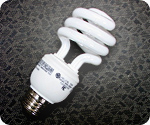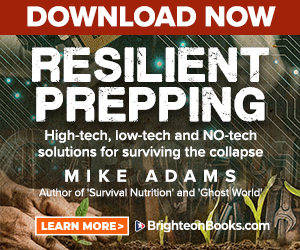
Compact fluorescent light bulbs contaminate the environment with 30,000 pounds of mercury each year
 Wednesday, June 20, 2007 Wednesday, June 20, 2007by Mike Adams, the Health Ranger Editor of NaturalNews.com (See all articles...) Tags: compact fluorescent lights, compact fluorescent lamps, health news |
- TAKE IT DOWN Act advances in Congress amid free speech concerns
- Hospital staffers sound alarm after 10 nurses were diagnosed with BRAIN TUMORS
- Analysis: The coming economic collapse, a mass uprising and Trump's three secret weapons to halt the growing revolt
- Widespread social and economic unrest: Steve Quayle issues urgent financial warning of imminent asset collapse in new interview with Mike Adams
- Fauci is back in the limelight, and he’s busy promoting a future COVID or FLU pandemic
- Israeli lobbyists boast of controlling US national security policy in leaked AIPAC audio
- Mike Adams releases country western hit single: Goin’ Back in Time is Comin’ Home
- Tulsi Gabbard leads charge against the Biden regime’s global censorship of the 'Disinformation Dozen'
- Kiss Your Genetic Privacy Good-Bye! 23andMe Gets Green Light to Sell Your Intimate Genetic Details to Anyone They Want
- Aerosolized bioweapons? Strange “diploid biomasses” falling out of the sky in Florida captured under the microscope
- CLOT SHOT PLANDEMIC UNFOLDING: Fibrous, rubbery clots caused by covid injections have prion-like seeding activity
- U.S. lawmakers investigate Meta over alleged China collaboration
- New studies ignite debate: Fluoride linked to autism and ADHD, prompting calls for policy reassessment
- Children’s Health Defense stands firm: Based on SCIENCE and personal experiences, the MMR vaccine is NEITHER SAFE nor EFFECTIVE
- Defunding DEADLY mRNA jabs: Government funding for mRNA technology being scrutinized and sidelined until proven "safe and effective" for real
- Sen. Ron Johnson accuses CDC official in charge of COVID-19 injections of deleting records amid Congressional GOP scrutiny
- Federal appeals court authorizes DOGE access to Education, Treasury and OPM records
- Shedding light on the dark side of MMR vaccines: How vaccinated individuals SPREAD MEASLES & put the vulnerable at risk
- Fauci is back in the limelight, and he’s busy promoting a future COVID or FLU pandemic
- Tulsi Gabbard leads charge against the Biden regime’s global censorship of the 'Disinformation Dozen'
- Aerosolized bioweapons? Strange “diploid biomasses” falling out of the sky in Florida captured under the microscope
- Analysis: The coming economic collapse, a mass uprising and Trump's three secret weapons to halt the growing revolt
- Kiss Your Genetic Privacy Good-Bye! 23andMe Gets Green Light to Sell Your Intimate Genetic Details to Anyone They Want
- Widespread social and economic unrest: Steve Quayle issues urgent financial warning of imminent asset collapse in new interview with Mike Adams
- U.S. lawmakers investigate Meta over alleged China collaboration
- Mike Adams releases country western hit single: Goin’ Back in Time is Comin’ Home
- Chemtrails unveiled: How the CIA and Big Business are manipulating the weather for profit
- Curcumin’s ancient healing power supercharges muscle recovery, and its effects are compounded with anti-inflammatory foods and supplements
- Tulsi Gabbard takes aim at censorship: Justice for the ‘Disinformation Dozen’
- China’s counter-tariff strategies: A new chapter in the U.S.-China trade war
- CLOT SHOT PLANDEMIC UNFOLDING: Fibrous, rubbery clots caused by covid injections have prion-like seeding activity
- Israeli lobbyists boast of controlling US national security policy in leaked AIPAC audio
- European Court of Justice: Healthcare professionals who promoted or administered COVID-19 vaccines are CRIMINALLY LIABLE for any harm caused
- Defunding DEADLY mRNA jabs: Government funding for mRNA technology being scrutinized and sidelined until proven "safe and effective" for real
- DEATH by VACCINE or face PRISON time: Canadian Freedom Convoy leaders CONVICTED for protesting forced vaccination during the Covid Plandemic
- U.S. approves new Russian ambassador as diplomatic thaw continues
- Newly released JFK files reveal Pentagon's role in creating Lyme disease and covid in the same lab
- Analysis: The coming economic collapse, a mass uprising and Trump's three secret weapons to halt the growing revolt
- Mike Adams releases country western hit single: Goin’ Back in Time is Comin’ Home
- Aerosolized bioweapons? Strange “diploid biomasses” falling out of the sky in Florida captured under the microscope
- Kiss Your Genetic Privacy Good-Bye! 23andMe Gets Green Light to Sell Your Intimate Genetic Details to Anyone They Want
- European Court of Justice: Healthcare professionals who promoted or administered COVID-19 vaccines are CRIMINALLY LIABLE for any harm caused
- Federal employees whine over DOGE's new directive requiring them to do a 5-point summary of weekly accomplishments
- Dr. Mike Yeadon releases 15-minute testimony - WATCH - about genocidal intent of COVID “vaccines”
- The Health Ranger releases “Vaccine Zombie” song and music video, using AI-animated zombies for the music video
- U.S. approves new Russian ambassador as diplomatic thaw continues
- Government waste exposed: Hegseth supports Musk’s demand for accountability from federal workers
- Trump reverses course on Gaza plan, says “nobody is expelling Palestinians”
- Now you can HEAR chemistry: Health Ranger translates molecules into music in stunning video demonstration that will blow your mind (and your ears)
- 5 Simple steps to boost your brainpower: How to strengthen executive function in a distracted world
- EPA advisor admits the agency is funneling billions to climate groups ahead of Trump’s return to White House
- A lack of integrity in Academia: Harvard professor found GUILTY of fraudulent research to promote CRT theory
- Rep. Nancy Mace introduces bill to ban biological males from female facilities on federal property
- Survival 101: Effective EMF blocking techniques
- Red Cross issues warning to stop blood plasma donations from vaccinated people
- Scientists confirm: GENIUS brain function can be spontaneously unleashed in humans without any apparent cause
- EPA advisor admits the agency is funneling billions to climate groups ahead of Trump’s return to White House
- HYSSOP: What research reveals about the health benefits of this ancient holy herb
- Two containers with completed ballots fall out of truck in Florida
- Newly released JFK files reveal Pentagon's role in creating Lyme disease and covid in the same lab
- Global leaders unite to clamp down on “misinformation” with UN-backed Cascais Declaration
- BREAKING: 2025 NDAA authorizes mandatory military draft of WOMEN across America… as Pentagon pursues global NUCLEAR war with both Russia and China at the same time
- Michael Yon warns of a ZIONIST TAKEOVER in Trump’s second administration
- Mike Adams releases country western hit single: Goin’ Back in Time is Comin’ Home
- Ozempic and Wegovy weight loss drugs are injectable LIZARD VENOM PEPTIDES that may unleash a devastating wave of organ failure… side effects align with symptoms of SNAKE BITES
- The Health Ranger releases “Vaccine Zombie” song and music video, using AI-animated zombies for the music video
- BOMBSHELL: DNA testing kits are a SCAM to develop ethnic-specific bioweapons
- Israeli soldiers accused of even more torture and abuse in the West Bank
- These 13 countries just signed an agreement to engineer a global FAMINE by destroying food supply
- NASA admits that climate change occurs because of changes in Earth’s solar orbit, and NOT because of SUVs and fossil fuels
- RFK Jr. clears key hurdle: Sen. Susan Collins backs controversial HHS nominee, signaling a new era for health policy
- Sermon 30: How Jesus reveals Caesar’s FAKE CURRENCY and FALSE AUTHORITY
Fluorescent lights are filled with a gas containing low-pressure mercury vapor and argon, or sometimes even krypton. The inner surface of the bulb is coated with a fluorescent coating made of varying blends of metallic and rare earth phosphor salts. Fluorescent light bulbs are more energy efficient than incandescent light bulbs of an equivalent brightness, and the efficiency of fluorescent lighting owes much to low-pressure mercury photon discharges. But fluorescents don't produce a steady light, and they burn out more quickly when cycled frequently; they also contain items such as fluorine, neon, and lead powder as well as mercury.
Measuring the environmental impact of mercury use in a particular product is more complicated than you might think. Mercury is an essential element in millions of fluorescent lamps throughout the world, and as those lamps are thrown into landfill, the mercury can escape and contribute to air and water pollution. (It can easily leach into groundwater supplies.)
According to www.lightbulbrecycling.com, each year an estimated 600 million fluorescent lamps are disposed of in U.S. landfills, amounting to 30,000 pounds of mercury waste. Astonishingly, that's almost half the amount of mercury emitted into the atmosphere by coal-fired power plants each year. It only takes 4mg of mercury to contaminate up to 7,000 gallons of freshwater, meaning that the 30,000 pounds of mercury thrown away in compact fluorescent light bulbs each year is enough to pollute nearly every lake, pond, river and stream in North America (not to mention the oceans).
Controlling the waste
Many state governing agencies have adopted their own regulations regarding the disposal of fluorescent lights. In California, Minnesota, Ohio, Illinois, Indiana, Michigan, and Wisconsin, it is unlawful for anyone to dispose of fluorescent bulbs as universal waste. These laws are based on the well-documented toxicity of the heavy metal mercury.Mercury (also called 'quicksilver') is a heavy, silvery transition metal most commonly found in thermometers, barometers, and other scientific apparatus. It is used in the electrical industry and in laboratory and medical instruments. Mercury is a known neurotoxin, and elevated blood mercury levels may lead to retardation and deformities in children. Chest pains, dyspnea, coughing, hemoptysis, and sometimes interstitial pneumonitis leading to death may follow acute inhalation exposure to mercury vapor. In America, 1 in 6 children born every year have been exposed to mercury levels so high that they are potentially at risk for learning disabilities, motor skill impairment and short-term memory loss.
If Americans adopt the use of even more compact fluorescent light bulbs, this ratio is like to substantially grow. Breaking one mercury light bulb in your home can contaminate your home to such a degree that hazardous materials experts are needed to remove the mercury. (At great cost, too. A typical mercury removal effort involving the breaking of a single fluorescent light can cost several thousand dollars.) The idea of allowing mercury to be placed in an easily breakable consumer product is fraught with public safety risks. In fact, it required a special exemption from the EPA to allow mercury-fluorescent lamps to be sold to consumers in the first place.
When a fluorescent light breaks, its vapors quickly escape and can be inhaled and absorbed through the skin. Most compounds of mercury are toxic, especially its organic compounds (such as methyl mercury).
A researcher at the University of Illinois at Springfield sums up the basic point behind these fluorescent bulbs: "People need to understand that these bulbs are considered "hazardous" and can cause long term damage to not only the environment, but if broken can cause health problems with people as well. Mercury has the ability to cause humans, as well as animals, serious health problems such as permanent nerve and kidney damage if exposed."
Alternatives to mercury-containing compact fluorescent lights
Fortunately, consumers no longer have to bring mercury into their homes through the use of fluorescent lights. There are now sensible alternatives. One of the most eco-friendly options is LED light bulbs which are not only mercury free, they're also 300% more energy efficient than fluorescent lights (and about 1000% more efficient than incandescent lights).Unlike incandescent light bulbs, which light up regardless of the electrical polarity, LEDs will only light with positive electrical polarity. LEDs produce more light per watt than do incandescent bulbs, and have an extremely long life span (usually about 50,000 hours). One manufacturer has calculated the ETTF (Estimated Time To Failure) for their LEDs to be between 100,000 and 1,000,000 hours, mostly depending on the operating temperature (the cooler the environment, the longer LEDs last). Fluorescent tubes, in contrast, are typically rated at about 10,000 hours, but in practical application, they only last about 2,000 - 3,000 hours. Incandescent light bulbs typically burn out every 1,000 hours. LEDs mostly fail by dimming over time, rather than with the abrupt burnout of incandescent bulbs.
One great advantage about LEDs is that they are difficult to damage with external shock. Fluorescent and incandescent bulbs, on the other hand, are easily broken if dropped on the ground.
LED lights contain absolutely no mercury or toxic chemicals, and conventional LEDs are made from a variety of inorganic semiconductor materials. They don't generate RF wavelengths that cause radio interference, or emit ultraviolet (UV) light -- so LEDs will not readily attract bugs and other insects.
For these reasons (very high energy efficient and the absence of toxic materials), I launched www.EcoLEDs.com in 2007, a company that now offers over a dozen LED light bulbs for consumer use, ranging in power from 3 watts to 10 watts (equivalent to a 100-watt incandescent light). These bulbs substantially reduce CO2 emissions due to their high energy efficiency. To learn more, visit www.BetterLifeGoods.com
Compact fluorescent lights at FETCH.news
Get independent news alerts on natural cures, food lab tests, cannabis medicine, science, robotics, drones, privacy and more.
 About the author:Mike Adams (aka the "Health Ranger") is a best selling author (#1 best selling science book on Amazon.com) and a globally recognized scientific researcher in clean foods. He serves as the founding editor of NaturalNews.com and the lab science director of an internationally accredited (ISO 17025) analytical laboratory known as CWC Labs. There, he was awarded a Certificate of Excellence for achieving extremely high accuracy in the analysis of toxic elements in unknown water samples using ICP-MS instrumentation. Adams is also highly proficient in running liquid chromatography, ion chromatography and mass spectrometry time-of-flight analytical instrumentation.
About the author:Mike Adams (aka the "Health Ranger") is a best selling author (#1 best selling science book on Amazon.com) and a globally recognized scientific researcher in clean foods. He serves as the founding editor of NaturalNews.com and the lab science director of an internationally accredited (ISO 17025) analytical laboratory known as CWC Labs. There, he was awarded a Certificate of Excellence for achieving extremely high accuracy in the analysis of toxic elements in unknown water samples using ICP-MS instrumentation. Adams is also highly proficient in running liquid chromatography, ion chromatography and mass spectrometry time-of-flight analytical instrumentation.
Adams is a person of color whose ancestors include Africans and Native American Indians. He's also of Native American heritage, which he credits as inspiring his "Health Ranger" passion for protecting life and nature against the destruction caused by chemicals, heavy metals and other forms of pollution.
Adams is the founder and publisher of the open source science journal Natural Science Journal, the author of numerous peer-reviewed science papers published by the journal, and the author of the world's first book that published ICP-MS heavy metals analysis results for foods, dietary supplements, pet food, spices and fast food. The book is entitled Food Forensics and is published by BenBella Books.
In his laboratory research, Adams has made numerous food safety breakthroughs such as revealing rice protein products imported from Asia to be contaminated with toxic heavy metals like lead, cadmium and tungsten. Adams was the first food science researcher to document high levels of tungsten in superfoods. He also discovered over 11 ppm lead in imported mangosteen powder, and led an industry-wide voluntary agreement to limit heavy metals in rice protein products.
In addition to his lab work, Adams is also the (non-paid) executive director of the non-profit Consumer Wellness Center (CWC), an organization that redirects 100% of its donations receipts to grant programs that teach children and women how to grow their own food or vastly improve their nutrition. Through the non-profit CWC, Adams also launched Nutrition Rescue, a program that donates essential vitamins to people in need. Click here to see some of the CWC success stories.
With a background in science and software technology, Adams is the original founder of the email newsletter technology company known as Arial Software. Using his technical experience combined with his love for natural health, Adams developed and deployed the content management system currently driving NaturalNews.com. He also engineered the high-level statistical algorithms that power SCIENCE.naturalnews.com, a massive research resource featuring over 10 million scientific studies.
Adams is well known for his incredibly popular consumer activism video blowing the lid on fake blueberries used throughout the food supply. He has also exposed "strange fibers" found in Chicken McNuggets, fake academic credentials of so-called health "gurus," dangerous "detox" products imported as battery acid and sold for oral consumption, fake acai berry scams, the California raw milk raids, the vaccine research fraud revealed by industry whistleblowers and many other topics.
Adams has also helped defend the rights of home gardeners and protect the medical freedom rights of parents. Adams is widely recognized to have made a remarkable global impact on issues like GMOs, vaccines, nutrition therapies, human consciousness.
In addition to his activism, Adams is an accomplished musician who has released over a dozen popular songs covering a variety of activism topics.
Click here to read a more detailed bio on Mike Adams, the Health Ranger, at HealthRanger.com.
Take Action: Support Natural News by linking to this article from your website
Permalink to this article:
Embed article link: (copy HTML code below):
Reprinting this article:
Non-commercial use OK, cite NaturalNews.com with clickable link.
Follow Natural News on Facebook, Twitter, Google Plus, and Pinterest
Science News & Studies
Medicine News and Information
Food News & Studies
Health News & Studies
Herbs News & Information
Pollution News & Studies
Cancer News & Studies
Climate News & Studies
Survival News & Information
Gear News & Information
News covering technology, stocks, hackers, and more



"Big Tech and mainstream media are constantly trying to silence the independent voices that dare to bring you the truth about toxic food ingredients, dangerous medications and the failed, fraudulent science of the profit-driven medical establishment.
Email is one of the best ways to make sure you stay informed, without the censorship of the tech giants (Google, Apple, Facebook, Twitter, YouTube, etc.). Stay informed and you'll even likely learn information that may help save your own life."
–The Health Ranger, Mike Adams













































